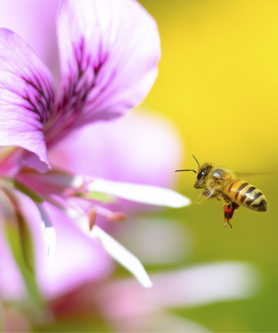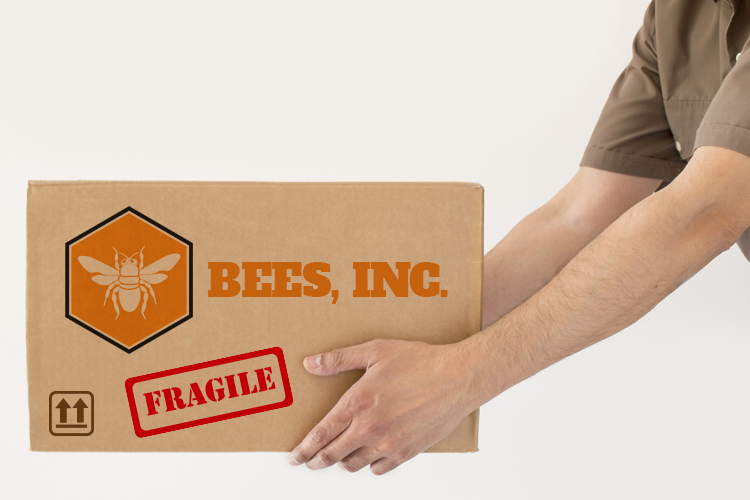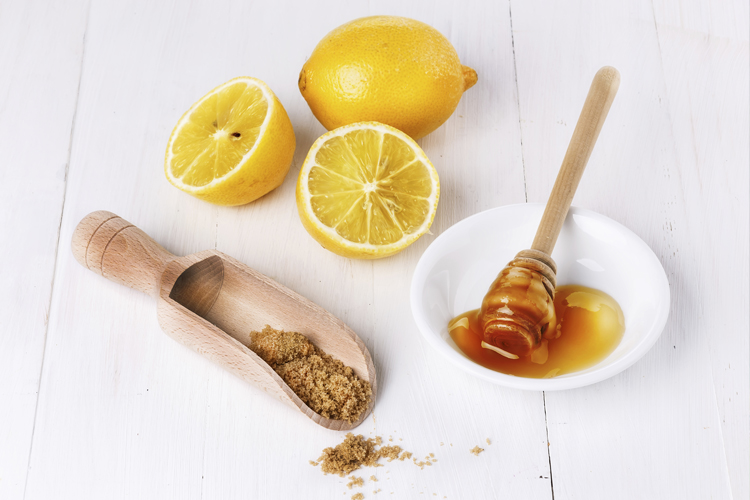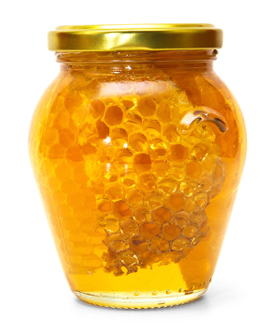The Secret Life of Beekeepers
[rev_slider Beekeeping]
The return of warm weather brings a peaceful buzz to Miriam Snyder’s backyard. Snyder and her husband, Matthew, keep bees for honey and for the environment. Their apiary hobby is a natural extension of their love for gardening and the outdoors. It requires minimal maintenance, especially in springtime, when nature provides everything the bees need for colony building and honey making: abundant blooms and fair temperatures. In a normal year, the Snyders would be looking forward to the best part about keeping bees: the honey. But this isn’t a normal year.
“We lost one hive a couple of years ago,” says Snyder, who is a physical education equipment aide at the College, “but this past year was the first time both hives died.” They don’t know why. “There were many dead bees in the hives,” says Miriam, which rules out ‘colony collapse disorder,’ the scenario where adult bees suddenly abandon a healthy working hive and cause it to fail. “But they had plenty of food, and there didn’t appear to have been a mite or wax moth problem.”
Even experienced apiarists, like the Snyders, can occasionally feel the sting of a failed hive.
In their Manor Lakes neighborhood of Rockville, the Snyder’s bees have prime conditions: ample hive space, a water source, gardens, and wood-lands for foraging. Generally, the bees follow pathways that do not disturb them, their dogs, or their neighbors. Forager bees and drones canvas a three-mile radius from the hive collecting and delivering nectar and pollen. Essentially, they are too busy to interact with inhabitants of their environs, unless absolutely necessary.
 Snyder rarely gets stung. A seasoned apiarist, she suits up in full protective clothing—a veil, gloves, and jumpsuit—only for intrusive work, like harvesting honey or treating problems. Other times, she just covers her arms and face. She uses a smoker to settle the bees before and during hive work, a centuries-old technique.
Snyder rarely gets stung. A seasoned apiarist, she suits up in full protective clothing—a veil, gloves, and jumpsuit—only for intrusive work, like harvesting honey or treating problems. Other times, she just covers her arms and face. She uses a smoker to settle the bees before and during hive work, a centuries-old technique.
“The trick,” she says, “is to move slowly and calmly.”
When a bee stings, she scrapes the stinger away with her fingernail. “Don’t pinch the stinger,” she says, “because you can inject yourself with additional venom.” As soon as possible afterward, she applies ice, takes an antihistamine, and elevates the affected body part. She follows up with a topical antihistamine lotion when it starts to itch a few days later.
Apiarists have varying hive management routines, but the overall consensus is the less intrusion the better. In spring and summer, Snyder checks her hives once a week to see whether the bees are laying eggs in the brood box, if there is honey in the cells, and for signs of trouble—mites or disease.
A thriving colony will continually generate new bees to sustain itself, and without adequate space, it will vacate en masse for new, more spacious digs—sometimes to inconvenient places like the neighbor’s shed or attic. Apiarists add frames or hives to prevent a swarm.
To extract honey, Snyder removes a frame from the hive and cuts the wax off the comb. She places it into an extractor (borrowed from their local beekeeping association). The machine use centrifugal force to draw honey out of the comb and into a receptacle. She strains the thick, golden honey by pouring it through woven cloth, removing bee wings and other impurities, then jars it for storing and sharing. The raw honey needs no processing or pasteurization; it is naturally antibacterial and safe to consume.
Although production varies from year to year, dependent mostly on weather conditions, each frame yields approximately three pounds of honey. In past years, the Snyders have enjoyed harvests of 30 to 60 pounds from 10 to 20 frames. After a harvest, the hive returns to normal operations quickly. In fall, when the days grow shorter and cooler, the bees naturally grow less active. Although not native to North America, they overwinter by huddling together inside the hive. Snyder provides a sugar-water solution and fondant to prevent starvation.
This year, however, since their bees did not survive the winter, there will be no Snyder honey; it takes a new colony more than a year to produce surplus stores. Rather than give up, the Snyders refilled their empty hives with a strain of European bees (Italian and Russian bees are the most common nowadays), purchased from a local breeder. The box of 2,500 to 3,000 bees cost $120. Days later, Miriam checked the hive to see whether the queen had been released yet. To free her, the adult bees must nibble away at the small sugar-sealed box where she resides. Once the queen moves in, the colony can begin to function properly.
 The bees’ comings and goings around the Snyder’s yard benefit the larger ecosystem. Honeybees pollinate 80 percent of crops, including fruits, legumes, and vegetables. The Maryland Department of Agriculture estimates honeybee pollination benefits $40 million in state vegetation. Their worth in food-chain production cannot be taken for granted.
The bees’ comings and goings around the Snyder’s yard benefit the larger ecosystem. Honeybees pollinate 80 percent of crops, including fruits, legumes, and vegetables. The Maryland Department of Agriculture estimates honeybee pollination benefits $40 million in state vegetation. Their worth in food-chain production cannot be taken for granted.
In recent years, adult honeybees began to disappear suddenly and without explanation. The live queen and immature bees remain, as do honey stores, but without the adult drones and other workers, the colony fails. The widespread phenomenon, called ‘colony collapse disorder,’ is still cause for alarm among scientists and agriculturalists.
“CCD, or colony collapse disorder, is a big concern nationally as well as internationally,” says Professor Steve Dubik, program coordinator of the landscape technology program.
To help the local community with beekeeping education and training, Dubik developed the College’s first beekeeping course, LN 141 Beekeeping. The inaugural class, held in summer 2014, drew wannabee beekeepers of all ages.
Led by instructor Gregg Gochnour, a county bee expert, inspector, and high school science teacher, students learn the basics of the honeybee life cycle and functions, seasonal management, parasite and pathogen management, and about products from the hive. They also work with live bees at hives on campus, which were established at Germantown with equipment donated by Chemistry Professor Don Newlin. At his peak, Newlin managed 30 hives on a half-acre property for more than 15 years. His hives yielded nearly 1,000 pounds of honey annually. Although he gave up the equipment, Newlin held onto a honey collection amassed from 60 different countries.
John Hamman, dean of mathematics and statistics, maintains the College hives. Hamman’s beekeeping expertise stems from his own experiences running a hobby farm with his wife, Kira. Along with chickens, a donkey, and a vegetable garden, they maintain two apiaries. Their honey goes to baking and gifting. The beeswax becomes soap, hand lotion, and conditioning for joints in woodworking projects.
“I believe in the mission of bees and beekeeping,” says Hamman. He points out the MC hive’s dual purpose of aiding instruction and pollinating the greenhouse plants next door. He is encouraged by increasing interest in beekeeping, something he considers an outgrowth of the sustainable living, buying local, and recycling movements.
“The sooner people realize their food doesn’t just appear in the supermarket, or on their plate in a restaurant, the better…. We don’t need big business to do this. We need 100 people keeping one colony each. More small-scale people keeping bees is good for everybody.”
—Diane Bosser
 Sweet Rewards
Sweet Rewards
Sean Kelly recalls ordering his first box of bees. The five-pound package of Italian honeybees with a queen was delivered to his local post office.
“I got the call as soon as the buzzing package arrived at the station and was told it would be greatly appreciated if I came and picked up my lively package that day.… I’ve been keeping bees ever since.”
He came to the hobby eight years ago, when a family friend shared stories about his own father and grandfather keeping bees.
“He talked about watching them in the yard, smoking the hive, getting ready to harvest the honey,” says Kelly. “I imagined myself doing the same. Once John showed me his hive, and I saw the bees shooting in and out, bringing food and water to the colony, I was hooked.”
Before starting his own hive, he read Beekeeping for Dummies and studied catalogs from industry giants, Dadant and Betterbee. Every year, he learns something new about the bees.
“It’s neat to watch them grow and pack the frames with honey, pollen, and larvae. It is exciting to be around all the bees knowing that if they chose to, they could give you a bad day. There can be 50,000 bees or more in a single hive.”
 Last summer Kelly had five swarms in one week; he was able to catch three of them. One of which he had to climb 30 feet up into a maple tree and knock them into a big plastic bag.
Last summer Kelly had five swarms in one week; he was able to catch three of them. One of which he had to climb 30 feet up into a maple tree and knock them into a big plastic bag.
“Keeping bees isn’t the easiest,” he says. “There have been times I thought of selling all my equipment and starting another hobby, but something has always pulled me back in when the times got tough.”
Sean Kelly is a landscape management student. He keeps three hives going while working full time as a landscaper and attending college part time.
 Health and Honey
Health and Honey
Honey as a food and medicine has its roots in ancient times. Neolithic cave art demonstrates honey-gathering as far back as 40,000 years. Mentions of honey appear throughout ancient and sacred writings, Sumerian Tablets (2100 BC) to Qurans, the Old Testament, and the East Indian healing tradition Ayurveda. Today, honey’s beneficial properties are supported by research. In addition to its natural sugars (glucose and fructose), honey contains small but valuable amounts of minerals, vitamins, amino acids, and other nutrients. Honey is also antibacterial, anti-viral, anti-fungal, and anti-parasitic. Medical researchers have re-discovered its ability to promote wound healing without encouraging antibiotic resistance.
Here are a few ways to include honey into your health and beauty routines:
Sore Throat
Place 2 tablespoons of honey into a glass of warm (not hot) water. Gargle for 30 seconds. Spit and repeat until all is used up. The honey serves two purposes here: it soothes raw tissues at the top of the throat, and it helps discourage pathogenic bacteria.
Facial Scrub
Mix raw honey with a bit of brown sugar, olive oil, and a touch of lemon juice. Use this as a gentle facial scrub. Leave off the lemon juice and it’s an aid for dry lips.
Honey Mask
The high sugar concentration in honey both kills bacteria and inhibits its growth. For teens prone to acne, they can rub warm (not hot) raw honey onto their face as a gentle “mask” to treat acne. Leave on for 30 minutes and  wash off with warm water.
wash off with warm water.
Purchase and Storage Tips
Wild, unprocessed honeys offer the most health benefits. Refining honey (heat and filtration) to make the perfectly clear honey seen in plastic honey-bear containers will diminish many of its health benefits. Consider buying small amounts of honey. Store in a cool, dark environment and use within 12 months. Always use a clean and dry spoon to dip the honey out of the jar.
Sarah Bachman Ducey, MS, CNS, is director of the Paul Peck Humanities Institute.


